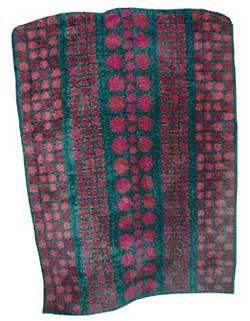Ryas Rugs

Rya means shaggy. Because the density of its pile is good insulation against the cold winters, the rya rug is found all over Scandinavia. Originally ryas rugs were woven on a loom with the pile knotted on the warp threads by hand but now you can use a canvas foundation and knot the wool with a ratchet hook. Rya rugs have an individual style of coloring. Each knot is made of three strands of wool which allows enormous scope for using different shades of color to build up a rich texture.
Patchwork quilts were rather common in peasant houses and
at the end of eighteenth century, their use spread to the upper class homes. The
rya rugs were very typical Finnish textiles, used primarily in open fishing
boats and sleighs, and later also as indoor textiles from the 16th century. Rya
rugs were used both to display one�s status and also in daily us in castles,
manor houses and commoners� houses. Rya rugs were hung on the walls and used as
bedcovers. Finland has also a long history of patchwork quilts, but very little
has been studied and documented in writing. However, there are several patchwork
quilts in Finnish museums, and whole cloth quilts and quilt frames were very
common in Finnish countryside homes. The Porvoo museum has on display a few old
embroidered silk quilts. These have been used as bridal quilts, and were popular
from 1700-1900. Viipuri and several other towns also have a history of quilting
guilds, where whole cloth bedcovers for winters were quilted.
Today, these deep pile shag rugs are Far Out. With designs influenced by
the space age 50's, the psychedelic 60's, and the
early mod 70's, Scandinavian Rya rugs saw a resurgence in popularity in the
West. Do not confuse these rugs with lesser priced
machine made rugs that carry the "Rya" name. These rugs are hand knotted wool,
and capture a Polaroid snapshot of what was happening
in Western Design in the Mid 20th Century.